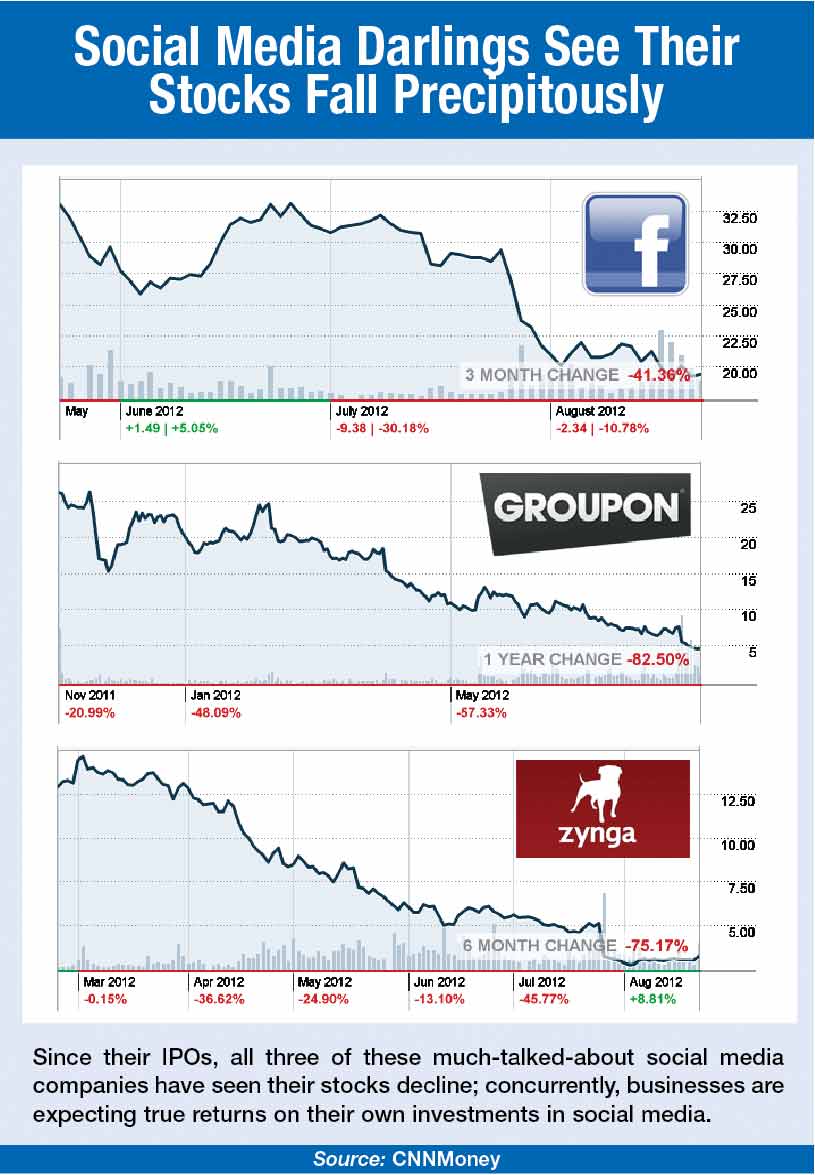Oh, the mighty has fallen. Since its IPO fiasco on May 18, 2012, Facebook has seen its stock price drop like an anvil. Since that fateful day, the social media stalwart has been rocked by lawsuits surrounding the IPO, defections by executives and, most recently, its stock being dumped by early investors, including—perhaps tellingly—20 million shares sold off by Peter Thiel, one of Facebook’s earliest financial backers and a member of its board of directors.
The stock is now hovering at about $20, almost half of its IPO price. But Facebook isn’t the only Silicon Valley social darling to fall—Zynga, the social media game maker, is now trading at about $3, down from its IPO price of $10. Not to be outdone, Groupon, the online daily deal site, has seen its stock price slide from $20 on its IPO in November 2011 to about $5 as of Aug. 24, 2012.
THE REAL VALUE
Thus, the stock of some of the biggest social media players has fallen dramatically. What does this do to the value of social media to organizations as a communications tool? Will company executives who control budgets and view stock price as a key indicator of worth sour on social media? Research so far is inconclusive. In the 7/30/12 issue of PR News, we reported that nearly 40% marketing executives found social media measurement and ROI was one of their greatest challenges. Yet in our 6/11/12 issue, we reported that 66% of corporate executives expected digital/social business would boost their operating income, (data per McKinsey).
So the signs are mixed. But out in the field, PR pros engaged with organizations’ social media programs don’t see any pulling back. On the contrary.
“We’re seeing a maturation in their understanding of social media,” says Dallas Lawrence, chief global digital strategist at Burson-Marsteller. Lawrence says the big brands he works with aren’t becoming social skeptics. Instead they are starting to ask the right questions about social media objectives. Lawrence paraphrases a quote by Coca-Cola’s director of social media Adam Brown: “Social media isn’t about impressions, it’s about expressions.”
While Brown’s quote touches a nerve, it may not be exactly what a bottom-line-focused CEO wants to hear. Yet Lawrence says leadership’s expectations are reshuffling. “Companies are looking beyond revenue and toward longer-term investment in social media,” he says.
That said, as social strategies mature, Lawrence predicts that companies may start to do less on the platform, but be more efficient.
 |
GREAT EXPECTATIONS
Don Bartholomew, SVP of digital and social media research at Ketchum, also believes there are greater expectations for social media. “Most people agree that 2010 was the year when social media crossed the chasm from experimentation to serious business,” says Bartholomew. Now that it’s a line item in budgets, the expectations are clearly changing, he says. Gone are the days when the numbers of likes and followers are the lead metrics. “I can’t tell you from in the past how many clients said ‘we want 3 million likes on Facebook,’” says Bartholomew. Those companies had little idea of what to do with those likes.
Now, smart companies are thinking about how social media can drive a business forward. That thinking, however, comes with a challenge: “Communications pros must be more accountable for results,” says Bartholomew.
HARD ROI EVIDENCE
Yet meaningful social metrics are elusive. Customer service, a function that deployed social media early, is a good entry point for demonstrating ROI, says Bartholomew. Before social media, a company might have eight people employed in a call center answering customer’s questions. Today, because of customers’ use of Twitter, a call center might be able to pare down staff from eight people to six. “That’s pure ROI based on savings,” he says.
E-commerce is another example of generating pure social media ROI: using social platforms to drive millions of people to unique URLs and microsites that directly result in sales. But demonstrating ROI from slowly building communities and conversations is more problematic.
To Lawrence, building communities and sharing content are the big benefits of social media, and companies are recognizing that. Results of the Burson-Marsteller Global Social Media Check-Up study, released in July 2012, bears that out, finding that Fortune 100 companies have an average of 10 corporate Twitter accounts each. “Companies are beginning to understand their audiences and where they go socially,” says Lawrence.
SOCIAL BLENDS IN
In the not-too-distant future, Lawrence can see dedicated social media divisions starting to shut down as the discipline fully integrates with traditional and digital PR outreach. In the meantime, Katie Paine of KDPaine & Partners sees no cutting back, citing a statistic that there’s some 20,000 job postings out there for community and/or social media managers. “More companies are realizing that they have to be in social media, and they need to hire people to do it,” she says.
Facebook, Groupon and Zynga? That’s just business, insists Paine. The best-run companies will adapt and win in the end.
And we predict that PR pros who successfully adapt to evolving social media expectations will also be victorious. PRN
[Hear more from Paine, Bartholomew and Lawrence at the PR News Social Media Measurement Conference in New York City on Oct. 2 (www.SocialMediaMeasureConference.com).
CONTACT:
Dallas Lawrence, [email protected]; Don Bartholomew, [email protected]; Katie Paine, [email protected].
Follow Scott Van Camp: @svancamp01
